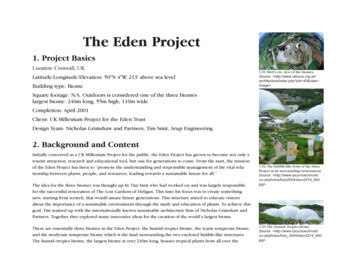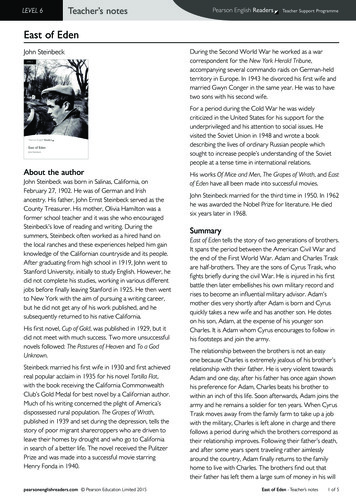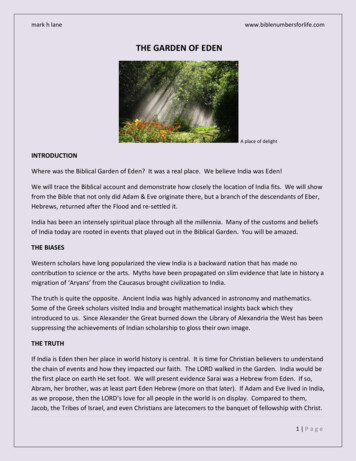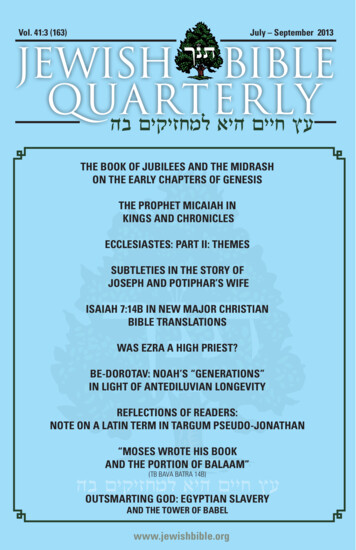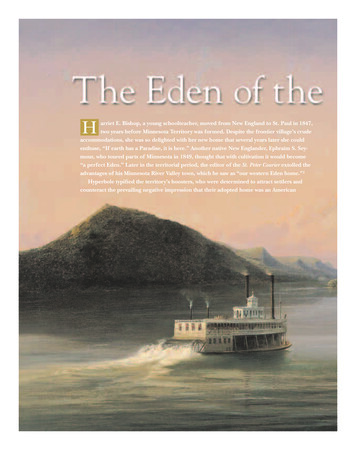
Transcription
MN History special 56/48/22/071:48 PMPage 202Harriet E. Bishop, a young schoolteacher, moved from New England to St. Paul in 1847,two years before Minnesota Territory was formed. Despite the frontier village’s crudeaccommodations, she was so delighted with her new home that several years later she couldenthuse, “If earth has a Paradise, it is here.” Another native New Englander, Ephraim S. Seymour, who toured parts of Minnesota in 1849, thought that with cultivation it would become“a perfect Eden.” Later in the territorial period, the editor of the St. Peter Courier extolled theadvantages of his Minnesota River Valley town, which he saw as “our western Eden home.”1Hyperbole typified the territory’s boosters, who were determined to attract settlers andcounteract the prevailing negative impression that their adopted home was an AmericanMH 56-4 Winter 98-99.pdf 568/22/07 1:57:56 PM
MN History special 56/48/22/071:48 PMPage 203WILLIAM E. LASSSiberia. Many prospective settlers perceived Minnesota as a remote, cold, desolate wildernessbeyond the nation’s agricultural pale. This reputation, along with the territory’s vastness andsparse population, troubled Alexander Ramsey, the first territorial governor, when he presented his inaugural message to the legislature on September 4, 1849.2Ramsey recognized that the extensive territory, bounded by Wisconsin on the east, Iowaon the south, the Missouri and White Earth Rivers on the west, and British possessions on thenorth, desperately needed settlers. A census taken in the summer of 1849 showed only 4,535whites and mixed-bloods living in the territory of about 166,000 square miles (nearly twicethe size of the later state). Other than the capital, St. Paul, the only settlements of note werePassenger-carrying paddle-wheelers a few miles below Red Wing graceFerdinand Reichardt’s scenic View of the Mississippi, 1857MH 56-4 Winter 98-99.pdf 578/22/07 1:57:56 PM
MN History special 56/48/22/071:48 PMPage 204Stillwater, Little Canada, St. Anthony, and the mixedblood community of Pembina in the Red River Valley.Ramsey’s address emphasized the common belief thatMinnesota’s future lay in agriculture. Since only aboutthree percent of the land within its official boundarieshad been acquired from the indigenous Dakota andOjibwe who lived there, Ramsey and other promotersbelieved that major Indian land cessions and heavy promotional advertising were vital to the territory’s rapiddevelopment.A variety of groups and individuals—newspapereditors, guidebook authors, excursionists, organizedcolonies of settlers, government officials, and speculators—promoted Minnesota’s acclaimed advantages.Newspapers, because of their regular distribution andrelatively wide circulation outside the territory, spearheaded the promotional offensive. Setting the stagewas James Madison Goodhue, the energetic editor ofthe Minnesota Pioneer, the territory’s first newspaper.Launching his paper, Goodhue proclaimed that “theinterests of Minnesota require an able and efficientpress, to represent abroad our wants and to set forthour situation, our resources and our advantages.” 3Until his death in August 1852, Goodhue was Minnesota’s best salesman. His zealous passion for the territory’s superiority was evident in his witty, colorful editorials and stories. He sometimes printed extra copies torespond to inquiries and to enable Minnesotans to mailthem to acquaintances back east. He also regularly sentcopies to newspapers serving areas where the most likely future Minnesotans lived—the New England, MiddleAtlantic, and Old Northwest states. Oftentimes, thesepapers reprinted his comments verbatim, providing freeadvertising for Minnesota.4Most other territorial newspapers used Goodhue’stactics to boast about Minnesota. John P. Owens, whosuccessively edited three St. Paul newspapers—theMinnesota Register, the Minnesota Chronicle and Register,and the Minnesotian—most closely resembled Goodhuein style, dedication, and methods. Probably the singlemost ambitious promotion was conducted by Charles G.Ames, the editor of St. Anthony’s Minnesota Republican.In a series of 13 articles titled “Minnesota as It Is,” Amesadvertised the territory’s climate, natural resources,agriculture, and lumbering.5Newspaper boosterism was at least matched by guidebook authors John Wesley Bond, Ephraim S. Seymour,Henry W. Hamilton, Charles Emerson, A. D. Munson,and Christoper C. Andrews. Bond, a young Pennsylvanian who moved to St. Paul in 1849 and accompaniedGovernor Ramsey on an 1851 expedition through the204Red River Valley, wrote Minnesota and Its Resources in1853 and produced updated editions in 1854, 1856,and 1857.6 Bond masterfully mixed fact and fiction byincluding accurate information on such things as population and land sales along with outlandish claims forthe area’s uniquely salubrious climate and the superiority of its people in morality, virtue, thrift, industriousness, enterprise, and intellect.When Seymour toured the St. Paul–St. Anthony–Stillwater area in 1849, he had already published adirectory to the lead-mining region of Galena, Illinois,where he lived, and an emigrants’ guide to the California gold mines.7 By giving his book the propagandistictitle Sketches of Minnesota, the New England of the West,Seymour suggested that the territory was a verdant,scenic area destined to be transformed into anothergreat center of civilization. Subsequently, promotersoften paid Minnesota their highest compliment by predicting it would be the country’s next New England.Bond’s book, published in Chicago and Philadelphia, and Seymour’s text, published in New York City,were often quoted by Minnesota and out-of-territorynewspapers, and both enjoyed a wide readership. Leaders in Northampton, Massachusetts, who were organizing a colony in Minnesota specifically recommendedSeymour’s book to members and likely recruits.8Although Henry W. Hamilton’s Rural Sketches ofMinnesota, The El Dorado of the North-west, published inMilan, Ohio, in 1850, was less widely circulated, it presented Minnesota even more favorably as a land akin tothe fabled place of precious minerals sought by Spanishexplorers. To Hamilton, Minnesota was a preferredalternative to California, which was being grandly promoted as the “New El Dorado” after the 1849 gold rush.A. D. Munson’s The Minnesota Messenger ContainingSketches of the Rise and Progress of Minnesota and Charles L.Emerson’s Rise and Progress of Minnesota Territory wereboth published in St. Paul in 1855 while the city andterritory were experiencing unprecedented growth.Munson reiterated the standard claims that Minnesotawas a haven for health seekers, and Emerson’s booklet,originally issued in October 1854 in the Minnesota Democrat when Emerson was its editor, emphasized St. Paul’svibrant economy.Christopher C. Andrews’s Minnesota and Dacotah,published in Washington, D.C., in 1857, was the territory’s last promotional book. Based on a series of popular letters Andrews sent to the Boston Post while touringMinnesota in 1856, it was not as overdone as some ofthe other books, but it nonetheless could have causedeager land seekers to imagine Minnnesota as theGarden of Eden.MINNESOTA HISTORYMH 56-4 Winter 98-99.pdf 588/22/07 1:57:57 PM
MN History special 56/48/22/071:48 PMPage 205Two of the best-known steamboat excursionists inthe early territorial years were women. The Swedishnovelist Fredrika Bremer, her international reputationalready well established, visited St. Paul and its environsin October 1850, a year after beginning her lengthytour of the United States.10Recognizing Bremer’s promotional potential, Governor Ramsey and his wife Anna hosted the celebrityduring her eight-day stay, and they must have felt gratified when her Homes of the New World, published in 1853,praised Minnesota’s agricultural potential and prophetically observed,This Minnesota is a glorious country, and just the country for Northern emigrants. . . . It is four times as largeas England; its soil is of the richest description, withextensive wooded tracts; great numbers of rivers andlakes abounding in fish, and a healthy, invigorating climate. . . . What a glorious new Scandinavia might notMinnesota become! 11Title page of the 1856 edition of John Wesley Bond’s earlybook promoting MinnesotaThousands of tourists also helped publicize theterritory. Typically they booked steamboat tours fromSt. Louis or Galena to St. Paul, the base for visiting sitessuch as the Falls of St. Anthony, Minnehaha Falls, andFort Snelling. The “Fashionable Tour,” as it came to beknown, was first proposed in 1835 by artist GeorgeCatlin, who aptly sensed the appeal of the MississippiRiver’s scenic attractions to well-to-do American andforeign travelers. By the late 1830s excursion tours originating in St. Louis had become popular, and the number of these fashionable excursions increased after accommodations in St. Paul improved.9American writer Elizabeth Ellet made a trip in 1852that became even more widely known than Bremer’s.A frequent contributor to national magazines such asGodey’s Lady’s Book, Ellet gloried in Minnesota’s sceneryand described Minnehaha Falls as a “vision of beauty”that formed “a scene of such enchanting loveliness as totake the senses captive, and steep the soul in the purestenjoyment this earth can afford.” Her travelogue, firstprinted serially in the New York Daily Tribune in Augustand September 1852, was excerpted by other newspapers including the St. Anthony Express. Her book SummerRambles in the West, published the next year, includedextensive coverage of Minnesota’s scenic attractions andpromoted fashionable tours.12The single greatest promotional act of the territorialperiod was the Rock Island Railroad Excursion of 1854.Upon reaching the Mississippi at Rock Island, Illinois,on February 22, the Chicago and Rock Island Railroadcelebrated by organizing an excursion to the head ofnavigation. Invited were hundreds of celebrities including politicians such as former president Millard Fillmore, businessmen, academicians, and journalists frommost major eastern newspapers and cities such as Chicago and Cincinnati.13The three-day tour proved so popular that its organizers had to employ five very crowded steamboatsto carry the 1,200 excursionists to St. Paul that June.During their one very long day in Minnesota, coachesand every other conceivable vehicle whisked them tothe Falls of St. Anthony, Lake Calhoun, MinnehahaFalls, and Fort Snelling. After a grand reception at theSt. Paul capitol hosted by Governor Willis A. Gorman,WINTER 1998–99MH 56-4 Winter 98-99.pdf 592058/22/07 1:57:57 PM
MN History special 56/48/22/071:48 PMPage 206by nationally known writer Catherine M. Sedgwick, waspublished in Putnam’s Monthly Magazine of September1854. But dozens of other stories about the scenic upper Mississippi appeared in newspapers. While rivertourists did not have an opportunity to become wellacquainted with the interior of Minnesota, they did seethe verdant river valley during the summer, which stimulated comparisons to New England. For example,Charles F. Babcock, editor of the New Haven Palladium,thought that the scenery at St. Paul and St. Anthony was“not unlike that observed in some of the drives aroundNew Haven.” As a result of the great excursion, Christopher C. Andrews reported, a remarkable 28,000 people visited St. Paul during the 1856 navigation season.14Fashionable visitors admiring Minnehaha Falls,front and backthe visitors departed just before midnight. Speaking atthe reception, Fillmore lauded in terms of just praisethe scenery and prospects of the country and expatiatedat length on its beauty and resources. A newspaperaccount continued, “He spoke of the adaptation ofSt. Paul as a summer place of fashionable resort, andbelieved it would eventually be connected in an unbroken chain of railway with the Atlantic and Pacific Oceans.He should go home with enlarged ideas of the futuregreatness of Minnesota.” Quite likely he had been madeaware that local boosters were predicting greatness forthe city because of its central location in the continent.Perhaps the most widely circulated article about thetrip, “The Great Excursion to the Falls of St. Anthony”206Leaders of organized settlement colonies becamesome of Minnesota’s most enthusiastic promoters. Theytypically formed organizations with a formal name, bylaws, and membership dues. Colonies were touted assuperior to individual settlement because advanceagents could preselect land claims and often handle thelegal requirements of obtaining titles. Once established,the group could cooperatively build homes, schools,and churches.Members of each colony often shared a unifying trait.The Minnesota Claim Association, for example, was usually called the Northampton Colony after the Massachusetts city where it was organized. Headed by Methodistclergymen Freeman Nutting and Henry Martyn Nicholsand extensively publicized for several months in theNorthampton Courier and by exchanges with other easternnewspapers, the organization sent settlers to Chanhassen, Faribault, and St. Peter in 1853. The MinnesotaSettlement Association of New York City concentrated oncity folk in its 1855 advertising blitz in the New York DailyTribune, and by spring 1856 it had garnered an impressive 250 members who prepared to move.15A territorial official played a strong hand in Minnesota’s most unique colony and definitely its greatestfailure. The Western Farm and Village Association ofNew York City represented a group of urban, workingclass members. Inspired by the physiocratic tradition ofthe naturalness of the yeoman farmer and, apparently,various utopian settlements, the association disparagedthe wage system in favor of agriculture. The decision tomove to Winona County in 1852 was in part a responseto Henry H. Sibley, territorial delegate to Congress.16Through his pamphlet, Minnesota Territory: Its PresentCondition and Prospects, and in correspondence with theassociation, Sibley glorified the prospects of living thegood life in rural Minnesota. He even introduced a proposal in the House of Representatives to grant 160 acresMINNESOTA HISTORYMH 56-4 Winter 98-99.pdf 608/22/07 1:57:57 PM
MN History special 56/48/22/071:48 PMPage 207of federal land to each association member. Despite thefailure of this private homestead bill, about 175 colonymembers moved to Rolling Stone in Winona County in1852. While their cause seemed noble, they were stunningly naive about the realities of frontier life. Disease,a high death rate, poor land selection, bad roads, andlack of supplies forced most of the colonists, includingthe chief organizer, to leave Rolling Stone within a fewmonths.Other officials who actively promoted Minnesotaincluded Alexander Ramsey and Willis A. Gorman.Ramsey skillfully used his annual messages to the legislature to praise Minnesota’s climate, healthfulness, agricultural potential, and future greatness. His words wereSplendid cabin of the steamboat Milwaukee (right)and the steamers Grey Eagle, Frank Steele, JeannetteRoberts, and Time and Tide at St. Paul’slower levee, 1859WINTER 1998–99MH 56-4 Winter 98-99.pdf 612078/22/07 1:57:57 PM
MN History special 56/48/22/071:48 PMPage 208distributed generously by Minnesota newspapers andsuch national business magazines as De Bow’s Review.Ramsey also promoted the territory officially inorder to more effectively compete with Wisconsin andother states that were using public funds and government employees to advertise for settlers. Ramsey andthe legislature were persuaded by William G. Le Duc tosponsor a Minnesota exhibit at the 1853 Crystal Palaceworld’s fair in New York City. As the appointed fair commissioner, Le Duc, an irregular correspondent for Horace Greeley’s New York Tribune and the publisher of thesomewhat promotional annual titled The Minnesota YearBook, was granted 300 to display Minnesota products.17As a result of his New York experience, Le Ducrecommended that Minnesota should officially beginrecruiting foreigners for settlement. The 1854 legislature considered that possibility but did not act. Ramsey’s successor, however, Willis A. Gorman, stronglyurged official promotion. Responding to his call, the1855 legislature created the position of Commissionerof Emigration, and Gorman then named Eugene Burnand, a Swiss immigrant who had recruited Europeansin New York, to the position.18As specified in the authorizing legislation,Burnand established his headquarters inNew York City where he could best meetEuropean immigrants and interest themin Minnesota. During his two-yeartenure, he also advertised the territory in European newspapers and corresponded with groups of immigrants who had recently moved toother American cities. Concentrating on Germans, Burnandsuccessfully persuaded many ofthem, including the CincinnatiGerman Association, whichplayed a key role in foundingNew Ulm, to move to Minnesota.While serving as territorialdelegate, Sibley made his firstpromotional effort in a February 15, 1850, letter to U.S. SenatorHenry S. Foote of Mississippi.Portraying Minnesota in glowingterms, the letter, first printed inthe Washington, D.C., Union,became the core of Sibley’s promotional pamphlet Minnesota Territory: Its Present Condition and Prospects, printedby the Washington Globe on February 20, 1852. Withslight changes it was again published in the Daily National Intelligencer (Washington) on November 5, 1852, andin some Minnesota newspapers.19Land speculators represented a last important sourceof territorial promotion. Although the press regularlyvilified them as greedy vultures who preyed on a vulnerable populace, speculators were not solely big-moniedinvestors. In truth, during the heady boom times beforethe devastating Panic of 1857, speculation permeatedall segments of Minnesota society. Johann Georg Kohl,a German geographer who visited Minnesota in 1855,observed that “in St. Paul, every shoemaker, every laborer, every maid, and every stableboy, whoever has savedmoney, dreams and fantasizes about a hole, a rock, aswamp, a thornbush, a piece of land or (as they sayhere) a lot outside the city somewhere.” 20Speculators and their allies came in many guises,including colonists, land-company agents, townsitepromoters, community boosters, and ordinary citizens.Using a pseudonym such as “Northwest,” “Benton,” orA hand-crafted wooden immigrant’s trunk from Norway, 1850s208MINNESOTA HISTORYMH 56-4 Winter 98-99.pdf 628/22/07 1:57:57 PM
MN History special 56/48/22/071:48 PMPage 209“T.” to send letters to Minnesota and out-of-state newspapers about the special qualities of their communities,they praised the territory’s farmland, crops, timber, millsites, and destiny of becoming a regional metropolis.Quite likely these authors were disguised agents forland companies, but some may have been nothing morethan another “Mr. Everyman,” whose own investmentdepended on the success of his town. Interestingly, bythe mid-1850s boom, the existence of speculation wasitself promoted as one of Minnesota’s great attractions,and stories of land values doubling or tripling in a fewmonths became commonplace.21Minnesota’s supposedly unique climate representeda challenge for promoters. Collectively defensive, theyresented any critical comments or inferences that Minnesota was a Siberia, a second Lapland, a polar region,or too far north for productive agriculture. Gormancomplained, for instance, that “during the past year Ihave received almost innumerable letters from the middle states propounding a variety of questions about ourterritory, especially desiring to know if our winters arenot very long, and so exceedingly cold that stock freezesto death, and man hardly dare venture out of his domicil.” Likewise, Burnand complained about agents fromsome states, whom he claimed frightened emigrantsfrom risking their lives “among the alledged [sic] mountains of ice in this Territory.” 22Minnesota’s spokesmen went to the opposite extreme by presenting its climate as the world’s best. Liketheir critics, they assumed the ridiculous posture thatclimate conformed to political boundaries and, thus,that Minnesota somehow had a climate distinctive evenfrom neighboring Iowa and Wisconsin. Most of theirverbiage was devoted to the winter season because it wasMinnesota’s bugbear. They described winters as dry,clear, calm, devoid of sharp temperature fluctuations,and invigorating. While newspaper editors and otherboosters sometimes presented winter-weather statistics,promoters preferred “bracing” as their favorite synonymfor cold. Summaries of winter weather usually includedcommentary that a really cold day was not really coldbecause people did not feel it to the extent they did inmore humid climates to the east and south.23On a philosophical plane, promoters contendedthat Minnesota’s climate in fact assured its future greatness. Their proof was the geopolitical notion that theworld’s great civilizations had developed in temperateclimatic zones. Editor Goodhue, for example, informedhis readers that “the human family, never has accomplished anything worthy of note, beside the erection ofpyramids, those milestones of ancient centuries, southA horse-drawn sleigh waits in front of a busy St. Anthonyland office in this 1/4-plate daguerreotype, about 1857.of latitude 40 degrees north. The history of the world, iswritten chiefly above that parallel.” 24Specifically relating that concept to Minnesota, anexpansive writer for De Bow’s Review claimed:There seems to be a certain zone of climate withinwhich humanity reaches the highest degree of physicaland mental power. . . . That zone, rizing northward bysome immutable law of nature, brought out from theSaxon family all its decided features of character. . . .That zone struck this country where the pilgrim andthe Quaker landed, and has ever since been streamingacross the continent in one unbroken path of progressand glory. . . . It is the good fortune of this Territory tolie not only within that zone, but within its very apex.25Such observations, which later seemed quaint, if notludicrous, were perfectly reasonable to those smittenwith the nationalistic fervor of Manifest Destiny. Ramseyexpressed the same sentiment when he declared thatthere was no movement of peoplerecorded in the annals of the world, that does not sinkin comparison by side of that marvellous Americanprogress, that astonishing growth and development ofour triumphant, irresistible civilization, which in itsWINTER 1998–99MH 56-4 Winter 98-99.pdf 632098/22/07 1:57:58 PM
MN History special 56/48/22/071:48 PMPage 210march to the uttermost extremities of the West, haspassed the barrier of the Alleghanies[sic], peopled thevalley of the Mississippi, crossed the Rocky Mountains,and planted our glorious liberty and benign institutions by the shores of the Pacific.26Promoters found a strong correlation between Minnesota’s winters and the sterling character of its people.They held that the long winters stimulated industriousness, frugality, inquisitiveness, enterprise, and intellect.Their reasoning was that Minnesotans had to work hardduring the growing season to prepare for winter, whichin turn was a time of contemplation, winter sports, andsocializing to share ideas. In assessing the nature ofMinnesotans, Bond observed:I speak in no boastful or vainglorious theme when Isay there is largely more character in Minnesota thanwas found at the same age in any of the older westernmembers of our republican family. I know the factfrom the experience of candid men, who have livedon other frontiers, and now bear testimony in favor ofMinnesota. Croakers and grumblers we may ever expect to find among us—drones and loafers; but thegreat family of the hive works together steadily andharmoniously. They, and those who are to come afterthem, will reap their reward in a glorious, happy, andenviable future.27The most extravagant claim about Minnesota’s climate was that it was salubrious. In addressing the first territorial legislature, Ramsey stated that the “Northern latitude saves us from the malaria and death, which in otherclimes are so often attendant upon a liberal soil.” Sibleyboldly proclaimed that in Minnesota “sickness has nodwelling place,” and in the same vein Goodhue declaredthat “never has a case of fever and ague originated here.”Such claims prompted some Minnesotans to joke that inorder to die they would have to leave the territory.28In territorial years there was a certain plausibility tothese extreme assertions. Until the mid-1870s the American public, including the medical profession, believedthat climatic features were primary causes of disease,and, hence, they accepted the premise of healthy andunhealthy climates. Americans also knew that newlyopened areas often were ravaged by diseases.29 Naturally preoccupied with their own health, it is not too surprising that some might have believed that somewhereon the globe there was a magnificent, salubrious climate.Coincidentally, the formation of Minnesota Territoryand a great cholera epidemic occurred within severalmonths of each other.210Introduced from western Europe, a strain of Asiaticcholera had devastated settled areas of the UnitedStates in 1832. Abating for 17 years, it resurfaced in1849, causing a national health crisis. New York City had5,017 cholera fatalities in a three-month period, and thedisease killed a tenth of the people in St. Louis. Thecalamity moved President Zachary Taylor to proclaimFriday, August 3, 1849, a national day of “fasting, humiliation and prayer” to implore the Almighty to lift thepestilence from the land.30Since cholera was especially prevalent in filthy,crowded cities with garbage heaps, uncollected animalwaste, and contaminated water, Minnesota escaped it in1849. This absence, which was errantly attributed to thesalubrious climate, gave credence to the territory’s promotional claims. But when cholera reappeared nationally in 1854 and 1855, Minnesota was not so fortunate.At least a dozen St. Paulites died from it in 1854, butcity promoters took steps to preserve the territory’s reputation for healthiness. Receiving a report from theboard of health about the cholera outbreak, the citycouncil squelched the information. Council minutesdid not mention the report, and city newspapers ignored it. Although cases probably increased in 1855,St. Paul’s newspapers only mentioned it twice.31Malaria or ague was perhaps the most dreaded disease in much of the nation. Especially prevalent in hotregions, it was believed to be caused by miasma, a vaporarising from warm-water swamps. Without knowledgethat malaria (a word contracted from the Italian malaaria or bad air) was transmitted by only certain types ofmosquitoes, Minnesota’s promoters bragged that itsabsence was attributable to the territory’s good air. Forexample, Bond assured his readers that after severalyears’ residency in Minnesota, “I can safely say that theatmosphere is more pure, pleasant, and healthful, thanthat of any other I have ever breathed on the continentof North or South America.” 32From time to time during the territorial period,Minnesota’s promoters changed the emphasis of theirhealth claims. References to cholera became uncommon after the 1849 epidemic, and comments on malaria were expanded to include any ailments associatedwith fevers. By later territorial years consumption hadbecome the disease for which Minnesota’s cool climatefrequently was claimed to be an elixir.The proof for claims of bringing good health wasonly anecdotal. Sometimes individuals testified that theclimate had improved or even cured them. PromoterHamilton cited the case of an acquaintance from Ohiowho “was thought to be consumptive and having heardmuch about this bracing and invigorating climate, heMINNESOTA HISTORYMH 56-4 Winter 98-99.pdf 648/22/07 1:57:58 PM
MN History special 56/48/22/071:48 PMPage 211thought he would try it, and see what effect it wouldhave upon his lungs. His health gradually improved,and before the following spring he was well and hearty,with an appetite like a Turk.” John H. Stevens, laterfamed as a founder of Minneapolis, was consumptivewhen he moved west in 1848. He wrote that his smallWisconsin party included a doctor, but after theyarrived in Minnesota, “There were no sick—the doctorleft in disgust.” In describing the area north of Stillwater, Seymour observed: “The healthiness of this placecan not be questioned. A single death by sickness hasnot occurred among the white population within thelast year. The only death was that of a young man, killedby the falling of a tree.” 33proof that all of Minnesota was potentially farmland wasoften repeated by other promoters.Although only a small portion of Minnesota was cultivated during the territorial years, promoters did nothesitate to boast about the productivity of its rich soils.Other advantages such as cheap land, nearby marketsfor farm produce at lumbering camps and Indian agencies, and accessibility to timber and water were also heldout as inducements to prospective settlers.36Emphasizing climate, health, and agriculture, promoters also praised Minnesota’s water transportation,waterpower, lumbering, scenery, and outdoor sports.In the prerailroad age, navigable waterways were amajor concern, and Minnesota’s growth seemed assuredbecause of its location at the head of the MississippiRiver and Great Lakes commercial arteries. During theearly territorial period, the Missouri River was prominently mentioned, but this stopped as the boundariesof the future state became evident. Promoters hada knack for making all of the Mississippi’s northernMinnesota publicists also promoted the territory’spotential for agriculture, playing on the popular American metaphor of the frontier as a future garden—a paradise created without travail by yeoman farmers. Waxingenthusiastic about the St. Paul–Stillwater area, Seymourpredicted that “it will, ere long,be dotted with farmhouses, andenl
tory’s last promotional book. Based on a series of popu-lar letters Andrews sent to the Boston Post while touring Minnesota in 1856, it was not as overdone as some of the other books, but it nonetheless could have caused eager land seekers to imagine Minnnesota as the Garden of Eden
